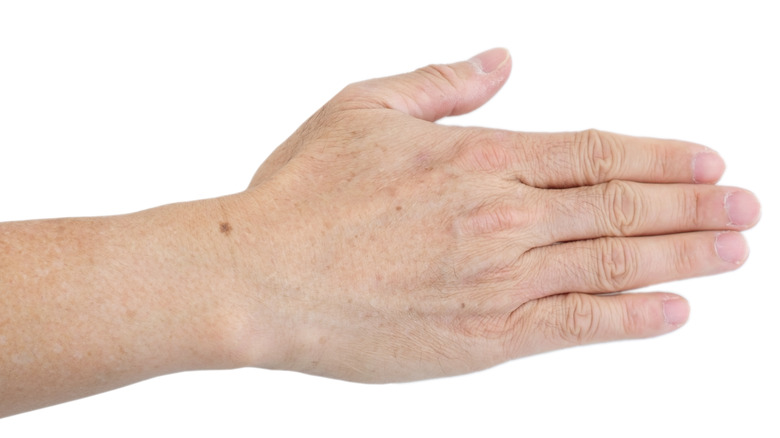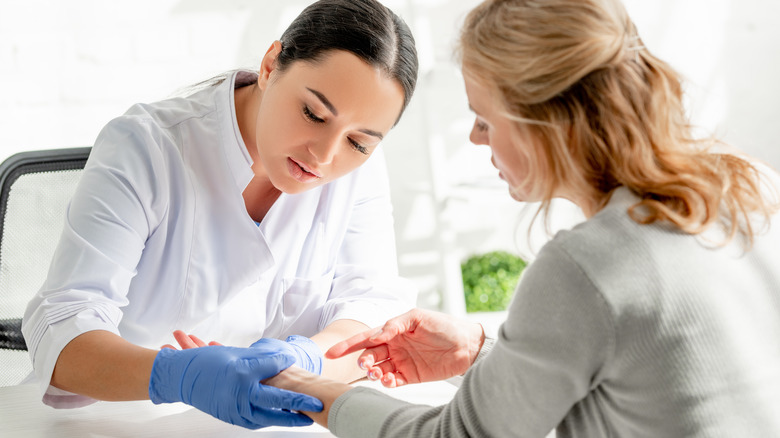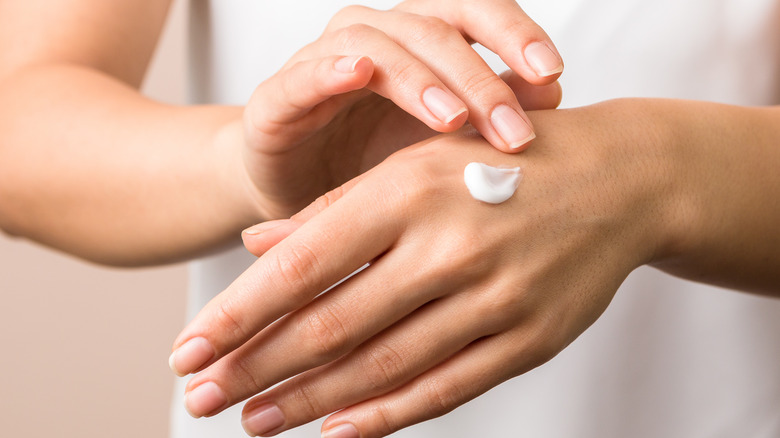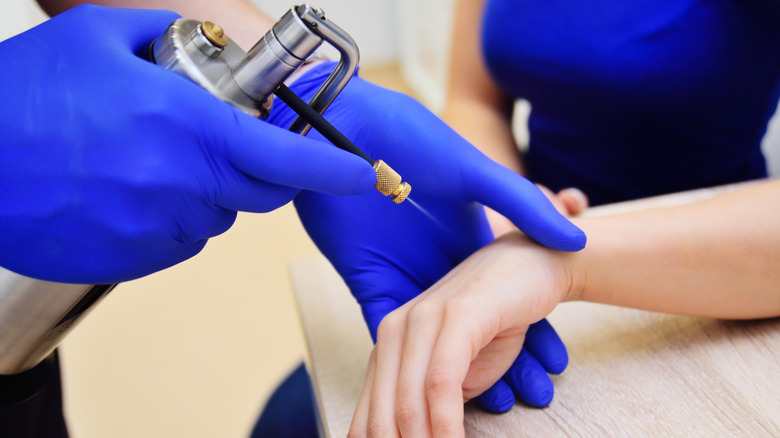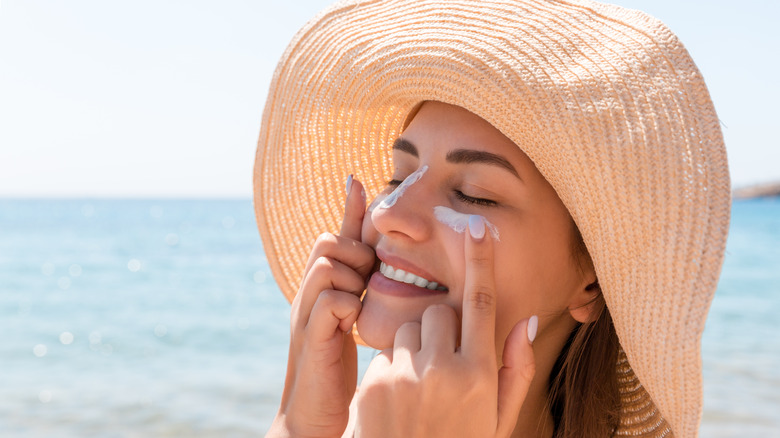How To Deal With Darkening Age Spots On Your Hands
No one wants to have age spots, but while they have something to do with aging, they aren't caused solely by growing old. Also known as liver spots or sunspots, they appear as a direct result of sun exposure so they can be a sign you're getting too much sun. Genetics also play a role so if they run in your family, you're more likely to have them.
These flat marks which can be brown, grey, or black are commonly found on the back of the hands as well as the face, forearms, chest, and upper back (via Healthline). They often occur in people over 40, but they can also turn up in people much younger. Size can vary and they can show up as single spots or clusters.
The good news is that age spots aren't cancerous and don't even need treatment. Still, many people want age spots removed, or at least learn how to prevent more from appearing.
See a dermatologist
Any time you notice changes in your skin, it's a sign to make an appointment with your dermatologist to get a diagnosis. According to the American Academy of Dermatology, some marks on the skin can look like age spots but actually aren't. These include seborrheic keratoses, harmless growths, actinic keratoses, a precancer, and even full-blown skin cancer.
A dermatologist may be able to gauge whether the spot is indeed a regular age spot just by looking at it. However, they may also choose to do a biopsy and send a piece of tissue to the lab, according to Healthline. This is a simple procedure that takes place right in the doctor's office and uses a local anesthetic so you don't feel anything.
If you assume a new growth is simply an age spot, you can delay treatment if it turns out to be cancerous. The more time that goes by without treatment, the quicker cancer can grow and possibly spread. So whenever you notice a new spot or mole, have it checked out by a professional.
Medicated creams to fade age spots
Once diagnosed, you have some options. The least invasive method for removing age spots is to use topical medication in the form of a cream. Several products are on the market claiming to get rid of age spots but the reality is that no medication can instantly remove them. In addition, some over-the-counter creams contain harmful ingredients like mercury. The U.S Food & Drug Administration has linked several skincare products to mercury poisoning.
The safest and most effective topical solutions are those prescribed by a dermatologist (via Cleveland Clinic). Dermatologists can also gauge which medication will work best for your skin and health history. Prescription creams include bleaching agents and retinoids to help lighten the spots over time. This requires some patience because the medication won't make a dramatic change overnight. Most take at least a few months to notice an improvement. Of all the available options, using a daily cream is an easy way to gradually fade troublesome age spots.
Dermabrasion, microabrasion, and cryotherapy
Dermabrasion is a procedure done in a dermatologist's office to basically scrape off the outer layer of the skin's surface, thereby removing the age spots. It requires the use of an electric-powered brush that rapidly rotates. It can be somewhat painful, so topical anesthetics are given beforehand to numb the skin.
Microabrasion is a less intense form of dermabrasion. Yet neither one works well for everyone. Besides the side effects including redness, tingling, burning, and itching, these procedures can worsen rosacea and visible veins.
Cryotherapy is the freezing of areas of the skin. Mayo Clinic explains that for age spots, cotton swabs that have been immersed in liquid nitrogen are applied to individual age spots to literally freeze them off. Something to know about cryotherapy is that it can result in itching, burning, and scarring, especially if you have sensitive skin.
With any invasive procedure, it's best to vet your dermatologist and make sure they have experience and good outcomes in performing the procedure you want to have.
Best way to prevent age spots
The best way to avoid sunspots is simple: stay out of the direct sun (via WebMD). Most of the time, that's easy enough when you're outside. Pick a shady spot over a sunny one when you're out but also pay attention to the sun's rays when you're inside. There is faulty thinking that just because you're in your apartment or car, you're protected, but if your desk is positioned by a sunlit window, or your arms are in the sun even though you're driving in an air-conditioned car, your skin is still absorbing sun rays.
When you have to be in the sun, wear sunscreen and make sure it's the right one. According to the Skin Cancer Foundation, sunscreen with at least an SPF of 30 is optimal. Remember that sunscreen isn't foolproof, so take additional steps. Wear a wide-brimmed hat to protect your fragile facial skin. Wear lightweight, light-colored clothing to put a barrier between your skin and the sun.
Go natural with sunspots
Since there's nothing inherently harmful about sunspots and they can simply be a natural change in your skin as it ages (especially if you're predisposed through genetics), you can opt for treating them naturally. Dermatological surgeon Dendy Engelman, MD told Byrdie that there are nature-based ways to treat troublesome age spots. She advises that papaya and yogurt can be good exfoliants, turmeric evens skin tone, and almond oil and aloe are soothing skin agents.
Accepting the spots as part of you may be all you need to do. You might even look at them as battle scars or at the very least the product of many good memories. By avoiding sun exposure you can try to keep them from darkening. It also helps to maintain a regular moisturizing routine to keep your hands soft and supple. Wear gloves when cleaning or doing the dishes. Apply lotion to your hands daily. Hydrated skin always looks more healthy and vibrant.
